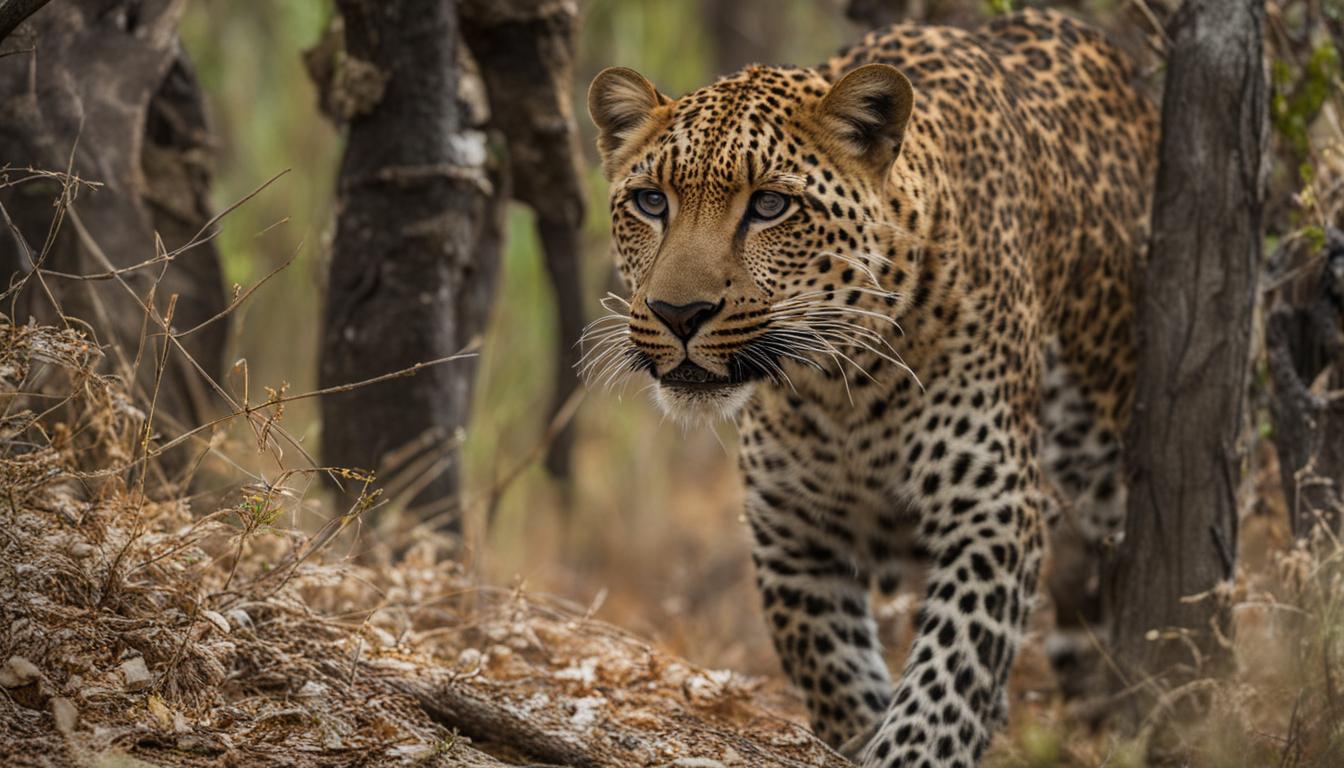The leopard (Panthera pardus) is classified as “vulnerable” on the IUCN Red List and faces various threats to its survival. The main threats to wild leopard populations include habitat loss, human-wildlife conflict, illegal hunting, poaching, prey depletion, climate change, deforestation, and fragmentation. These threats have led to significant declines in leopard populations across Africa, Asia, and other regions.
Habitat Loss and Fragmentation
Leopards, majestic creatures known for their adaptability, are facing a significant threat due to habitat loss and fragmentation. These feline predators once roamed vast territories, but human activities such as agriculture, deforestation, and urbanization are rapidly destroying their habitats. As a result, leopards struggle to find suitable areas to live and hunt, leading to a decline in their populations.
Habitat loss is particularly detrimental to leopard populations as it reduces the availability of resources and disrupts their natural behavior. Leopards require diverse habitats, ranging from deserts to forests to grasslands, to meet their ecological needs. However, as these habitats diminish, the leopards’ ability to find food and shelter is compromised. This, in turn, leads to conflicts with humans and other wildlife species, as leopards may encroach on human settlements or compete with other predators for limited resources.
Leopards need our urgent attention and conservation efforts to protect their habitat and ensure their survival. By safeguarding the diverse landscapes they inhabit, we can secure a future for these iconic big cats.
Habitat fragmentation exacerbates the effects of habitat loss. When large areas of leopard habitat are divided into smaller, isolated patches, it restricts their movement and gene flow. This isolation hampers their ability to find mates, resulting in reduced genetic diversity and an increased risk of inbreeding. Furthermore, fragmented habitats can lead to increased human-wildlife conflict as leopards are forced into closer proximity with human settlements. The loss and fragmentation of leopard habitats must be addressed through conservation efforts to prevent further decline in their populations.
Table: Leopard populations affected by habitat loss and fragmentation
| Region | Impact |
|---|---|
| Africa | Drastic reduction in leopard populations due to deforestation and urbanization |
| Asia | Loss of natural habitats, leading to human-leopard conflicts |
| South America | Fragmentation resulting from agricultural expansion affecting leopard populations |
The conservation of leopard populations hinges on addressing the threats of habitat loss and fragmentation. Efforts must be made to protect and restore their habitats, create wildlife corridors to facilitate movement between fragmented areas, and promote sustainable land-use practices. By working together, we can ensure that leopards continue to grace our planet with their presence and inspire awe for generations to come.
Human-Wildlife Conflict
As human populations continue to expand and encroach upon leopard habitats, conflicts between humans and leopards have become increasingly common. The interaction between humans and leopards often results in negative outcomes, such as leopard attacks on humans and livestock killings by leopards. This human-wildlife conflict poses a significant threat to both leopards and the livelihoods of local communities.
Leopards are opportunistic hunters and may prey on livestock when their natural prey is scarce. This can lead to retaliation from farmers and herders who may resort to killing the leopards in order to protect their animals and livelihoods. Additionally, the fear and perception of leopards as dangerous predators further exacerbate the conflicts, often leading to the persecution and killing of these majestic creatures.
“The conflict between humans and leopards is a complex issue that requires a multi-faceted approach. We need to find a balance between conserving leopard populations and addressing the concerns and needs of local communities.” – Wildlife Conservation Expert
To mitigate human-wildlife conflict, it is essential to implement effective conservation strategies that take into account the needs of both humans and leopards. This includes improving livestock management practices, such as using stronger enclosures and employing guard animals to deter leopard attacks. Providing education and awareness programs to local communities can also help foster a better understanding of leopards and promote coexistence.
Furthermore, creating protected areas and wildlife corridors can help reduce the encounters between humans and leopards, providing leopards with suitable habitats while minimizing the risk to human settlements and livestock. By addressing the underlying causes of conflict and promoting peaceful coexistence, we can work towards ensuring the survival of both humans and wild leopards.

Impact of Human-Wildlife Conflict
The impact of human-wildlife conflict extends beyond the direct harm caused to humans and leopards. Livelihoods dependent on agriculture and livestock can be severely affected, leading to economic hardship for local communities. Moreover, the loss of leopards can disrupt the balance of ecosystems, as they play a crucial role in regulating prey populations and maintaining biodiversity.
Illegal Hunting and Poaching
The illegal hunting and poaching of leopards pose significant threats to their survival. These majestic creatures are targeted for their valuable skins, claws, and other body parts, which are highly sought after in the wildlife trade. The demand for leopard skins, in particular, drives the illegal hunting and poaching activities.
The trade in leopard skins is fueled by the belief that they have medicinal properties and are used for making ceremonial robes and home decor. This demand has led to a decline in leopard populations as poachers continue to exploit these magnificent animals for profit.
To combat illegal hunting and poaching, strict enforcement of wildlife laws is crucial. International cooperation is also necessary to crack down on the illegal wildlife trade, ensuring that those involved in these criminal activities are brought to justice. It is only through concerted efforts that we can protect these beautiful creatures and ensure their survival for future generations.
Table: Leopard Poaching Statistics by Region
| Region | Number of Leopards Poached |
|---|---|
| Africa | 2,500 |
| Asia | 1,200 |
| South America | 500 |
| Other Regions | 300 |
The table above provides an overview of leopard poaching statistics by region. It highlights the alarming number of leopards that are hunted and killed illegally each year. These numbers underscore the urgent need for stronger conservation measures and increased efforts to combat illegal hunting and poaching.
Prey Depletion
One of the primary threats to wild leopard populations is prey depletion. As human activities continue to impact the environment, prey populations have been declining, leaving leopards with fewer food sources. This decline in prey populations is a result of various factors, including illegal hunting and habitat loss. As a result, leopards face increased competition with other predators for limited prey resources.
The decline in prey populations not only affects the survival of leopards but also disrupts the delicate balance of ecosystems. Leopards play a crucial role in regulating prey populations, and their absence can lead to imbalances in the food chain. Additionally, competition with other predators, such as feral dogs, further reduces the availability of prey for leopards. This situation poses a significant threat to the survival of leopards and the overall biodiversity of their habitats.
To illustrate the impact of prey depletion, let’s take a look at a comparison table:
| Prey Species | Before Decline | After Decline |
|---|---|---|
| Wild Sheep | Abundant | Scarce |
| Goats | Plentiful | Rare |
| Smaller Mammals | Diverse | Diminished |
As seen in the table above, the decline in prey populations is evident across various species. The scarcity of prey makes it increasingly difficult for leopards to find sufficient food, leading to malnutrition and population decline. Addressing prey depletion is essential for the long-term survival of leopards and the ecological balance of their habitats.
Climate Change
Climate change is a significant threat to wild leopard populations, impacting their habitat and survival. Rising temperatures and changing weather patterns have profound effects on the ecosystems where leopards reside. The rapid pace of climate change exacerbates existing threats faced by leopards, such as habitat loss and prey depletion.
The impact of climate change on leopard habitat is evident in mountainous regions, which are particularly vulnerable. Rising temperatures can result in the melting of glaciers and loss of critical water sources for both leopards and their prey. This further disrupts the delicate balance of the ecosystem, making it difficult for leopards to find suitable hunting grounds and exacerbating competition with other predators.
Furthermore, changing vegetation patterns associated with climate change also contribute to the decline in leopard habitats. As temperatures rise, certain plant species may struggle to survive, leading to shifts in vegetation composition and distribution. Leopards rely on specific vegetation types for cover, camouflage, and hunting success. Any disruption in these natural patterns can have detrimental effects on the leopard’s ability to survive.

In order to mitigate the impact of climate change on leopard populations, it is crucial to address the root causes of climate change and reduce greenhouse gas emissions. Additionally, conservation efforts must focus on the preservation and restoration of leopard habitats, ensuring the availability of suitable habitats for leopards to thrive. By taking proactive measures to combat climate change and protect leopard habitats, we can help secure a future for these magnificent creatures.
Trophy Hunting and Management Issues
Trophy hunting and management of problem leopards are two key issues that have an impact on the conservation of wild leopard populations. Trophy hunting refers to the practice of hunting leopards for sport, with the intention of obtaining their body parts or trophies as trophies. While regulated in some areas, trophy hunting can have negative consequences for leopard populations, especially when hunting occurs outside of protected areas.
One of the main concerns with trophy hunting is the potential for overharvesting, which can lead to a decline in leopard populations. When hunting is not properly managed or regulated, it can result in the removal of a significant number of leopards from the population, disrupting the balance and sustainability of the species. Additionally, trophy hunting can also result in the selective removal of large, mature individuals, which can have long-term effects on the genetic diversity and overall health of the leopard population.
Management of problem leopards is another issue that needs to be addressed in order to ensure the survival of the species. Problem leopards are individuals that come into conflict with humans, often preying on livestock or posing a threat to human safety. In some cases, problem leopards are killed in an attempt to mitigate these conflicts. However, it is important to develop and implement non-lethal methods of managing problem leopards, such as the use of deterrents, relocation, or the establishment of buffer zones between human settlements and leopard habitats.
Trophy Hunting Regulation and Alternatives
In order to address the negative impacts of trophy hunting, it is crucial to have effective regulation and monitoring in place. This includes setting quotas based on scientific assessments of leopard populations, ensuring that hunting is sustainable and does not pose a threat to the long-term survival of the species. Furthermore, strict enforcement of hunting regulations and penalties for illegal hunting are essential to combat the illegal trade of leopard parts and protect leopard populations.
Additionally, promoting alternative forms of wildlife tourism can provide economic incentives for local communities to protect leopards and their habitats. Ecotourism, such as wildlife safaris and photography tours, can generate revenue and create jobs, while also raising awareness about the importance of conserving leopards and their ecosystems. By shifting the focus away from trophy hunting and towards responsible and sustainable tourism, we can ensure the long-term survival of these magnificent animals.
| Trophy Hunting and Management Issues | Impacts on Leopard Populations |
|---|---|
| Trophy hunting | – Overharvesting and potential decline in leopard populations – Selective removal of large, mature individuals |
| Management of problem leopards | – Non-lethal methods needed to mitigate conflicts – Deterrents, relocation, and buffer zones |
| Trophy hunting regulation and alternatives | – Effective regulation and monitoring – Setting quotas based on scientific assessments – Strict enforcement of hunting regulations – Promoting alternative forms of wildlife tourism |
Conclusion
In conclusion, the threats facing wild leopard populations are significant and diverse, putting these majestic creatures at risk. Habitat loss, human-wildlife conflict, illegal hunting, prey depletion, climate change, trophy hunting, and management issues all contribute to the decline in leopard populations. However, there is hope for their conservation.
To protect leopards, conservation efforts must focus on preserving and restoring their habitats, reducing human-wildlife conflict, and enforcing wildlife laws. By safeguarding their habitats, we can provide leopards with the space they need to thrive and maintain healthy populations. It is also crucial to address the issue of human-wildlife conflict, finding sustainable solutions that ensure the safety of both leopards and local communities.
Combatting illegal hunting and wildlife trade is essential for leopard conservation. Strict enforcement of wildlife laws and international cooperation can help curb the demand for leopard skins and body parts, ultimately protecting these animals from further harm. Furthermore, efforts should be made to address prey depletion, ensuring a healthy and abundant food source for leopards. Climate change and trophy hunting also pose challenges that must be addressed through proper management and conservation strategies.
By coming together, individuals, organizations, and governments can make a difference in safeguarding the future of wild leopards. Their conservation is not only important for their survival but also for the overall health and balance of ecosystems. Let us work hand in hand to protect these iconic creatures and ensure that future generations can witness their beauty in the wild.
Are the threats facing wild leopard and cheetah populations similar?
Yes, the primary threats to wild cheetahs and leopards are similar. Both face habitat loss, human-wildlife conflict, and poaching. The decline in prey species also impacts both populations. Conservation efforts for these iconic big cats should address these common threats to ensure their survival in the wild.
FAQ
What are the primary threats facing wild leopard populations?
The primary threats facing wild leopard populations include habitat loss, human-wildlife conflict, illegal hunting, poaching, prey depletion, climate change, trophy hunting, and management issues.
How does habitat loss and fragmentation affect leopard populations?
Habitat loss and fragmentation due to human activities such as agriculture, deforestation, and urbanization have led to a significant decline in leopard populations. Leopards struggle to find suitable areas to live and hunt.
What is human-wildlife conflict and how does it impact leopards?
Human-wildlife conflict occurs when leopards prey on livestock, leading to retaliation from farmers and herders. This conflict poses a threat to both leopards and humans, resulting in the loss of livelihoods and the killing of leopards.
What is the impact of illegal hunting and poaching on leopard populations?
Leopards are targeted by illegal hunters and poachers for their skins, claws, and other body parts, which are in high demand in the wildlife trade. This trade contributes to the decline in leopard populations and threatens their survival.
How does prey depletion affect leopard survival?
Prey depletion, caused by factors such as illegal hunting and habitat loss, reduces the availability of food for leopards. Competition with other predators, such as feral dogs, further reduces prey availability and poses a significant threat to leopard survival.
What is the impact of climate change on leopard habitats?
Climate change is causing rising temperatures and changes in vegetation patterns, which impact leopard habitats. Rising temperatures and changes in vegetation can lead to the loss of suitable habitat and a decline in prey availability, ultimately threatening the survival of leopards.
How does trophy hunting and management issues affect leopard populations?
Trophy hunting, particularly outside of protected areas, can negatively impact leopard populations. Captive breeding of big carnivores in private ranches also poses a threat, as it can reduce the availability of prey for wild leopards.
What conservation efforts are being made to protect leopard populations?
Conservation efforts focused on protecting and restoring habitats, reducing human-wildlife conflict, and enforcing wildlife laws are crucial to mitigating the threats facing leopard populations and ensuring their long-term survival.










